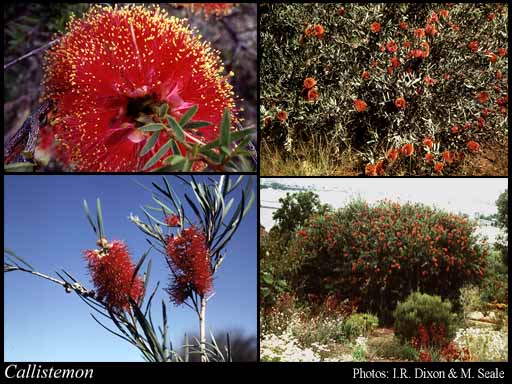- Reference
- Voy.Terra Austral. 2:547 (1814)
- Name Status
- Current







Scientific Description
Common name. Bottlebrushes. Family Myrtaceae.
Habit and leaf form. Trees, or shrubs; evergreen; bearing essential oils. Plants with neither basal nor terminal concentrations of leaves; to 1–12 m high. Leptocaul. Helophytic to xerophytic. Leaves small to medium-sized; alternate; leathery; petiolate, or subsessile, or sessile; gland-dotted; aromatic; edgewise to the stem, or with ‘normal’ orientation; simple; epulvinate. Leaf blades dorsiventral, or isobilateral, or centric; entire; flat, or rolled, or solid; terete; linear, or lanceolate, or oblong, or ovate; linear, or ovate, or obovate, or elliptic; pinnately veined, or parallel-veined, or one-veined; cross-venulate, or without cross-venules. Leaves without stipules; without a persistent basal meristem. Stem anatomy. Secondary thickening developing from a conventional cambial ring.
Reproductive type, pollination. Fertile flowers hermaphrodite. Unisexual flowers absent. Plants hermaphrodite (or rarely apomictic). Floral nectaries present. Nectar secretion from the androecium (the nectar moving up from the nectary/staminal ring to be exuded through the porous base of the filaments). Entomophilous, or ornithophilous. Pollination mechanism unspecialized.
Inflorescence and flower features. Flowers aggregated in ‘inflorescences’; in spikes. Inflorescences simple. The terminal inflorescence unit cymose. Inflorescences terminal (at first, then axis growing into a leafy shoot); oblong to cylindric; usually with involucral bracts, or without involucral bracts. Involucral bracts deciduous. Inflorescences pseudanthial. Flowers sessile (or slightly immersed in the woody axis); bracteate. Bracts deciduous. Flowers (bi) bracteolate, or ebracteolate; small to medium-sized; regular; cyclic. Free hypanthium present (petals ‘inserted on the calyx’); campanulate to urceolate; extending beyond ovary. Hypogynous disk present (lining the hypanthium). Perianth with distinct calyx and corolla; 10; 2 -whorled; isomerous. Calyx present; 5; 1 -whorled; polysepalous; imbricate; exceeded by the corolla; not persistent (or semi-persistent). Sepals ovate, or orbicular. Corolla present; 5; 1 -whorled; polypetalous; imbricate; regular; hairy abaxially, or glabrous abaxially; hairy adaxially, or glabrous adaxially; plain; green, or cream, or yellow, or pink. Petals elliptic, or ovate, or orbicular. Androecial members indefinite in number. Androecium 16–70(–100) (i.e. to ‘many’). Androecial members branched. Androecial sequence determinable, or not determinable. Androecial members if ‘many’, maturing centripetally; free of the perianth; all equal; free of one another, or coherent (rarely, shortly united at the base); when united, 1 - adelphous (connate into a short tube). Stamens 16–70(–100); attached on the rim of the hypanthium; becoming exserted (exceeding the petals); polystemonous; alternisepalous and oppositisepalous; both opposite and alternating with the corolla members; erect in bud, or inflexed in bud. Filaments not geniculate; hairy (bearded), or glabrous (usually); filiform. Anthers dorsifixed; not erect; versatile; dehiscing via longitudinal slits; introrse; tetrasporangiate; appendaged (with a prominent gland), or unappendaged. Gynoecium 3 carpelled, or 4 carpelled. The pistil 3 celled, or 4 celled. Gynoecium syncarpous; eu-syncarpous; partly inferior. Ovary plurilocular; 3 locular, or 4 locular. Ovary summit hairy, the hairs not confined to radiating bands. Epigynous disk absent. Gynoecium stylate. Styles 1; from a depression at the top of the ovary; apical; becoming exserted. Stigmas 1; capitate. Placentation axile. Ovules 50 per locule (i.e. ‘many’); ascending (on the peltate placenta); non-arillate; anatropous.
Fruit and seed features. Fruit often persistent (and enlarging for many years); non-fleshy (woody); dehiscent; a capsule (3–4-valved). Capsules loculicidal. Fruit numerous. Seeds non-endospermic; linear-cuneate; minute; wingless. Cotyledons 2.
Geography, cytology, number of species. Native of Australia. Not endemic to Australia (a few anamalous species in New Caledonia). Australian states and territories: Western Australia, South Australia, Northern Territory, Queensland, New South Wales, Victoria, Australian Capital Territory, and Tasmania. South-West Botanical Province.
Etymology. From the Greek and Latin for "beautiful" and "thread or stamen".
Taxonomic Literature
- Wheeler, Judy; Marchant, Neville; Lewington, Margaret; Graham, Lorraine 2002. Flora of the south west, Bunbury, Augusta, Denmark. Volume 2, dicotyledons. Australian Biological Resources Study.. Canberra..
- Lumley, P. F.; Spencer, R. D. 1988. Nomenclatural notes on Callistemon R.Br. (Myrtaceae).
- Marchant, N. G.; Wheeler, J. R.; Rye, B. L.; Bennett, E. M.; Lander, N. S.; Macfarlane, T. D.; Western Australian Herbarium 1987. Flora of the Perth region. Part one. Western Australian Herbarium.. [Perth]..
- Blackall, William E.; Grieve, Brian J. 1980. How to know Western Australian wildflowers : a key to the flora of the extratropical regions of Western Australia. Part IIIA. University of W.A. Press.. [Perth]..